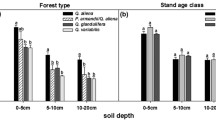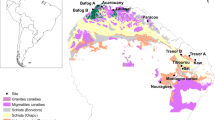Abstract
Ecosystem-level studies identify plant–soil feedbacks as important controls on soil nutrient availability, particularly for nitrogen and phosphorus. Although site- and species-specific studies of tree species–soil relationships are relatively common, comparatively fewer studies consider multiple co-existing species in old-growth forests across a range of sites that vary in underlying soil fertility. We characterized patterns in forest floor and mineral soil nutrients associated with four common tree species across eight undisturbed old-growth forests in Oregon, USA, and used two complementary conceptual models to assess tree species–soil relationships. Plant–soil feedbacks that could reinforce site-level differences in nutrient availability were assessed using the context-dependent relationships model, whereby relative species-based differences in each soil nutrient diverged or converged as nutrient status changed across sites. Tree species–soil relationships that did not reflect strong feedbacks were evaluated using a site-independent relationships model, whereby forest floor and surface mineral soil nutrient pools differed consistently by tree species across sites, without variation in deeper mineral soils. We found that the organically cycled elements carbon, nitrogen, and phosphorus exhibited context-dependent differences among species in both forest floor and mineral soil, and most often followed a divergence model, whereby species differences were greatest at high-nutrient sites. These patterns are consistent with theory emphasizing biotic control of these elements through plant–soil feedback mechanisms. Site-independent species differences were strongest for pools of the weatherable cations calcium, magnesium, potassium, as well as phosphorus, in mineral soils. Site-independent species differences in forest floor nutrients were attributable to one species that displayed significantly greater forest floor mass accumulation. Our findings confirm that site-independent and context-dependent tree species-soil relationships occur simultaneously in old-growth temperate forests, with context-dependent relationships strongest for organically cycled elements, and site-independent relationships strongest for weatherable elements with inorganic cycling phases. These models provide complementary explanations for patterns of nutrient accumulation and cycling in mixed-species old-growth temperate forests.



Similar content being viewed by others

References
Alban DH. 1969. The influence of western hemlock and western redcedar on soil properties. Soil Sci Soc Am Proc 33:453–7.
Binkley D. 1995. The influence of tree species on forest soils: processes and patterns. In: Mead DJ, Cornforth IS, Eds. Proceedings of the Trees and Soil Workshop, Lincoln University, 1994. Agronomy Society of New Zealand Special Publication Number 10, Lincoln University Press, Canterbury, New Zealand. pp 1–33.
Binkley D, Giardina C. 1998. Why do tree species affects soils? The warp and woof of tree-soil interactions. Biogeochemistry 42:89–106.
Boettcher SE, Kalisz PJ. 1990. Single-tree influence on soil properties in the mountains of eastern Kentucky. Ecology 71:1365–72.
Bormann BT, Cromack K Jr, Russell WO III. 1994. The influences of red alder on soils and long-term ecosystem productivity. In: Hibbs DE, DeBell DS, Tarrant RF, Eds. The biology and management of red alder. Corvallis, OR: Oregon State University Press. pp 47–56.
Bormann BT, Homann PS, Darbyshire RL, Morrissette BA. 2008. Intense forest wildfire sharply reduces soil C and N: the first direct evidence. Can J For Res 38:2771–83.
Chapin FS III, Matson PA, Mooney HA. 2002. Principles of terrestrial ecosystem ecology. New York: Springer-Verlag.
Davidson EA, Eckert RW, Hart SC, Firestone MK. 1989. Direct extraction of microbial biomass nitrogen from forest and grassland soils of California. Soil Biol Biochem 21:773–8.
Dijkstra FA. 2003. Calcium mineralization in the forest floor and surface soil beneath different tree species of the northeastern US. For Ecol Manag 175:185–94.
Dijkstra FA, Smits MM. 2002. Tree species effects on calcium cycling: the role of calcium uptake in deep soils. Ecosystems 5:385–98.
Ehrenfeld JG, Ravit B, Elgersma K. 2005. Feedback in the plant-soil system. Annu Rev Environ Resour 30:75–115.
Finzi AC, Canham CD, van Breemen N. 1998a. Canopy tree-soil interactions within temperate forests: species effects on pH and cations. Ecol Appl 8:447–54.
Finzi AC, van Breemen N, Canham CD. 1998b. Canopy tree-soil interactions within temperate forests: species effects on carbon and nitrogen. Ecol Appl 8:440–6.
Giesen TW, Perakis SS, Cromack K Jr. 2008. Four centuries of soil carbon and nitrogen change after stand-replacing fire in a forest landscape in the western Cascade Range of Oregon. Can J For Res 38:2455–64.
Gómez-Aparicio L, Canham CD. 2008. Neighborhood models of the effects of invasive tree species on ecosystem processes. Ecol Monogr 78:69–86.
Jenny H. 1941. Factors of soil formation. New York: McGraw-Hill.
Jobbágy EG, Jackson RB. 2001. The distribution of soil nutrients with depth: global patterns and the imprint of plants. Biogeochemistry 53:51–77.
Jobbágy EG, Jackson RB. 2004. The uplift of soil nutrients by plants: biogeochemical consequences across scales. Ecology 85:2380–9.
Knoepp JD, Swank WT. 1998. Rates of nitrogen mineralization across an elevation and vegetation gradient in the southern Appalachians. Plant Soil 204:235–41.
Lovett GM, Mitchell MJ. 2004. Sugar maple and nitrogen cycling in the forests of eastern North America. Front Ecol Evol 2:81–8.
Lovett GM, Rueth H. 1999. Soil nitrogen transformations in beech and maple stands along a nitrogen deposition gradient. Ecol Appl 9:1330–44.
Lovett GM, Weathers KC, Arthur MA, Schultz JC. 2004. Nitrogen cycling in a northern hardwood forest: do species matter? Biogeochemistry 67:289–308.
McLaughlin SB, Wimmer R. 1999. Calcium physiology and terrestrial ecosystem processes. Tansley Review No. 104. New Phytol 142:373–417.
Pastor J, Aber JD, McClaugherty CA. 1984. Aboveground production and N and P cycling along a nitrogen mineralization gradient on Blackhawk Island, Wisconsin. Ecology 65:256–68.
Perakis SS, Maguire DA, Bullen TD, Cromack K Jr, Waring RH, Boyle JR. 2006. Coupled nitrogen and calcium cycles in forests of the Oregon Coast Range. Ecosystems 9:63–74.
Prescott CF, Chappell HN, Vesterdal L. 2000. Nitrogen turnover in forest floors of coastal Douglas-fir at sites differing in soil nitrogen capital. Ecology 81:1878–86.
Reich PB, Aber JD, Grigal DF, Gower ST. 1997. Nitrogen mineralization and productivity in 50 hardwood and conifer stands on diverse soils. Ecology 78:335–47.
Spies TA, Franklin JF. 1991. The structure of natural young, mature, and old-growth Douglas-fir forests in Oregon and Washington USA. U S Forest Service General Technical Report PNW. pp 91–110.
Sterner RW, Elser JJ. 2002. Ecological stoichiometry. Princeton, NJ: Princeton University Press.
Tarrant RF, Isaac LA, Chandler RF. 1951. Observations on litter fall and foliage nutrient content of some Pacific Northwest tree species. J For 49:914–15.
Templer PH, Lovett GM, Weathers KC, Findlay SE, Dawson TE. 2005. Influence of tree species on forest nitrogen retention in the Catskill Mountains, New York, USA. Ecosystems 8:1–16.
Thiel AL, Perakis SS. 2009. Nitrogen dynamics across silvicultural canopy gaps in young forests of western Oregon. For Ecol Manag 258:273–87.
van Breeman N, Finzi AC, Canham CD. 1997. Canopy tree–soil interactions within temperate forest: effects of soil elemental composition and texture on species distributions. Can J For Res 27:1110–16.
van Breemen N, Finzi AC. 1998. Plant–soil interactions: ecological aspects and evolutionary implications. Biogeochemistry 42:1–19.
Vitousek PM. 1982. Nutrient cycling and nutrient use efficiency. Am Nat 119:553–72.
Vitousek PM, Porder S, Houlton BZ, Chadwick O. 2010. Terrestrial phosphorus limitation: mechanisms, implications and nitrogen-phosphorus interactions. Ecol Appl 20:5–15.
Walker RB, Gessel SP. 1991. Mineral deficiencies of coastal northwest conifers. Seattle, WA: University of Washington.
Wedin DA, Tilman D. 1990. Species effects on nitrogen cycling: a test with perennial grasses. Oecologia 84:433–41.
Zinke PJ. 1962. The pattern of influence of individual forest trees on soil properties. Ecology 43:130–3.
Acknowledgments
We thank Chris Catricala and crew for assistance in the field and laboratory, Lisa Ganio for statistical consulting, and David Hibbs, Kermit Cromack, David Myrold, and two anonymous reviewers for comments on the manuscript. This research was produced through the Cooperative Forest Ecosystem Research Program, with funding provided by the US Geological Survey Forest and Rangeland Ecosystem Science Center and the Oregon Department of Forestry. Any use of trade names is for descriptive purposes only and does not imply endorsement by the US Government.
Author information
Authors and Affiliations
Corresponding author
Additional information
Author Contributions
AC and SSP designed the study, AC performed the research, and SSP and AC wrote the paper.
Rights and permissions
About this article
Cite this article
Cross, A., Perakis, S.S. Complementary Models of Tree Species–Soil Relationships in Old-Growth Temperate Forests. Ecosystems 14, 248–260 (2011). https://doi.org/10.1007/s10021-010-9407-5
Received:
Accepted:
Published:
Issue Date:
DOI: https://doi.org/10.1007/s10021-010-9407-5



